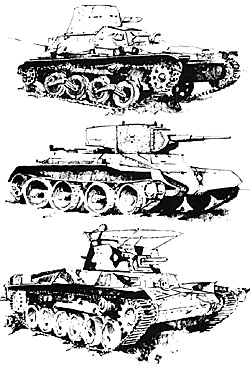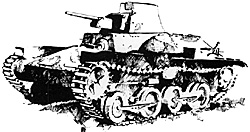
TANKETTE TYPE 94 TK
Top: A good liaison and reconnaissance vehicle, the Japanese tankette usually fared well against enemy infantry and cavalry. They were useless, however, in armor encounters. One-third of all Japanese AFVs at Nomonhan were of the tankette type.
| Weight | 2.65 tons |
| Crew | 2 |
| Speed | 25 m.p.h. |
| Range | 100 miles |
| Armament | one 6.5mm MG |
| Armor: Hull and Turret | 4mm to 12mm |
RUSSIAN BT-5
Middle: This early Russian tank (as well as Japanese types) had vision slits and pistol ports meant for use by the crews. Unfortunately, these only helped the enemy infantrymen who swarmed over the vehicles trying to destroy them.
| Weight | 11.5 tons |
| Crew | 3 |
| Speed | 39 m.p.h. |
| Range | 125 miles |
| Armament | one 45mm Type 97 gun (115 rounds); one 7.62mm MG (2,394 rounds) |
| Armor: Hull and Turret | 10mm to 13mm |
TYPE 97 MEDIUM TANK "CHI-HA"
Bottom: The best Japanese tank at Nomonhan, capable of engaging Russian BT tanks on an even basis. Most Japanese tanks included one MG firing forward in the hull, and one in the turret aiming to the rear.
| Weight | 14.3 tons |
| Crew | 4 |
| Speed | 23.5 m.p.h. |
| Range | 130.5 miles |
| Armament | one 57mm gun (114 rounds); two 7.7mm MG (4,35 rounds). |
| Armor: Hull and Turret | 25mm. |
TYPE 95 LIGHT TANK

Right: The Type 95 was specially designed for use in Manchuria. It was first used in combat by the Independent Mixed Brigade of the Japanese China Expeditionary Army. All Japanese tanks suffered from poor armor protection during the war.
| Weight | 7.4 tons |
| Crew | 3 |
| Speed | 22 m.p.h. |
| Range | 175 miles |
| Armament | one 37mm Type 97 gun; two 7.7mm MG. |
| Armor: Hull and Turret | 4mm to 12mm. |
More Nomonhan (Khalkhin-Gol)
-
Introduction
1st Phase (May 1939)
2nd Phase (July 1939)
3rd Phase (August 1939)
Japanese TO&Es: 23rd Div. and Yamagata Detachment
Four Vehicle Specs and Illustrations (72K)
Five Large Combat Maps (extremely slow: 708K)
Four Jumbo Combat Maps (monstrously slow: 1.2MB)
Back to Table of Contents -- Conflict Number 5
Back to Conflict List of Issues
Back to MagWeb Master Magazine List
© Copyright 1973 by Dana Lombardy.
This article appears in MagWeb (Magazine Web) on the Internet World Wide Web. Other military history articles and gaming articles are available at http://www.magweb.com